5.9: Maintain My Mental Health
- Page ID
- 14092
\( \newcommand{\vecs}[1]{\overset { \scriptstyle \rightharpoonup} {\mathbf{#1}} } \)
\( \newcommand{\vecd}[1]{\overset{-\!-\!\rightharpoonup}{\vphantom{a}\smash {#1}}} \)
\( \newcommand{\id}{\mathrm{id}}\) \( \newcommand{\Span}{\mathrm{span}}\)
( \newcommand{\kernel}{\mathrm{null}\,}\) \( \newcommand{\range}{\mathrm{range}\,}\)
\( \newcommand{\RealPart}{\mathrm{Re}}\) \( \newcommand{\ImaginaryPart}{\mathrm{Im}}\)
\( \newcommand{\Argument}{\mathrm{Arg}}\) \( \newcommand{\norm}[1]{\| #1 \|}\)
\( \newcommand{\inner}[2]{\langle #1, #2 \rangle}\)
\( \newcommand{\Span}{\mathrm{span}}\)
\( \newcommand{\id}{\mathrm{id}}\)
\( \newcommand{\Span}{\mathrm{span}}\)
\( \newcommand{\kernel}{\mathrm{null}\,}\)
\( \newcommand{\range}{\mathrm{range}\,}\)
\( \newcommand{\RealPart}{\mathrm{Re}}\)
\( \newcommand{\ImaginaryPart}{\mathrm{Im}}\)
\( \newcommand{\Argument}{\mathrm{Arg}}\)
\( \newcommand{\norm}[1]{\| #1 \|}\)
\( \newcommand{\inner}[2]{\langle #1, #2 \rangle}\)
\( \newcommand{\Span}{\mathrm{span}}\) \( \newcommand{\AA}{\unicode[.8,0]{x212B}}\)
\( \newcommand{\vectorA}[1]{\vec{#1}} % arrow\)
\( \newcommand{\vectorAt}[1]{\vec{\text{#1}}} % arrow\)
\( \newcommand{\vectorB}[1]{\overset { \scriptstyle \rightharpoonup} {\mathbf{#1}} } \)
\( \newcommand{\vectorC}[1]{\textbf{#1}} \)
\( \newcommand{\vectorD}[1]{\overrightarrow{#1}} \)
\( \newcommand{\vectorDt}[1]{\overrightarrow{\text{#1}}} \)
\( \newcommand{\vectE}[1]{\overset{-\!-\!\rightharpoonup}{\vphantom{a}\smash{\mathbf {#1}}}} \)
\( \newcommand{\vecs}[1]{\overset { \scriptstyle \rightharpoonup} {\mathbf{#1}} } \)
\( \newcommand{\vecd}[1]{\overset{-\!-\!\rightharpoonup}{\vphantom{a}\smash {#1}}} \)
\(\newcommand{\avec}{\mathbf a}\) \(\newcommand{\bvec}{\mathbf b}\) \(\newcommand{\cvec}{\mathbf c}\) \(\newcommand{\dvec}{\mathbf d}\) \(\newcommand{\dtil}{\widetilde{\mathbf d}}\) \(\newcommand{\evec}{\mathbf e}\) \(\newcommand{\fvec}{\mathbf f}\) \(\newcommand{\nvec}{\mathbf n}\) \(\newcommand{\pvec}{\mathbf p}\) \(\newcommand{\qvec}{\mathbf q}\) \(\newcommand{\svec}{\mathbf s}\) \(\newcommand{\tvec}{\mathbf t}\) \(\newcommand{\uvec}{\mathbf u}\) \(\newcommand{\vvec}{\mathbf v}\) \(\newcommand{\wvec}{\mathbf w}\) \(\newcommand{\xvec}{\mathbf x}\) \(\newcommand{\yvec}{\mathbf y}\) \(\newcommand{\zvec}{\mathbf z}\) \(\newcommand{\rvec}{\mathbf r}\) \(\newcommand{\mvec}{\mathbf m}\) \(\newcommand{\zerovec}{\mathbf 0}\) \(\newcommand{\onevec}{\mathbf 1}\) \(\newcommand{\real}{\mathbb R}\) \(\newcommand{\twovec}[2]{\left[\begin{array}{r}#1 \\ #2 \end{array}\right]}\) \(\newcommand{\ctwovec}[2]{\left[\begin{array}{c}#1 \\ #2 \end{array}\right]}\) \(\newcommand{\threevec}[3]{\left[\begin{array}{r}#1 \\ #2 \\ #3 \end{array}\right]}\) \(\newcommand{\cthreevec}[3]{\left[\begin{array}{c}#1 \\ #2 \\ #3 \end{array}\right]}\) \(\newcommand{\fourvec}[4]{\left[\begin{array}{r}#1 \\ #2 \\ #3 \\ #4 \end{array}\right]}\) \(\newcommand{\cfourvec}[4]{\left[\begin{array}{c}#1 \\ #2 \\ #3 \\ #4 \end{array}\right]}\) \(\newcommand{\fivevec}[5]{\left[\begin{array}{r}#1 \\ #2 \\ #3 \\ #4 \\ #5 \\ \end{array}\right]}\) \(\newcommand{\cfivevec}[5]{\left[\begin{array}{c}#1 \\ #2 \\ #3 \\ #4 \\ #5 \\ \end{array}\right]}\) \(\newcommand{\mattwo}[4]{\left[\begin{array}{rr}#1 \amp #2 \\ #3 \amp #4 \\ \end{array}\right]}\) \(\newcommand{\laspan}[1]{\text{Span}\{#1\}}\) \(\newcommand{\bcal}{\cal B}\) \(\newcommand{\ccal}{\cal C}\) \(\newcommand{\scal}{\cal S}\) \(\newcommand{\wcal}{\cal W}\) \(\newcommand{\ecal}{\cal E}\) \(\newcommand{\coords}[2]{\left\{#1\right\}_{#2}}\) \(\newcommand{\gray}[1]{\color{gray}{#1}}\) \(\newcommand{\lgray}[1]{\color{lightgray}{#1}}\) \(\newcommand{\rank}{\operatorname{rank}}\) \(\newcommand{\row}{\text{Row}}\) \(\newcommand{\col}{\text{Col}}\) \(\renewcommand{\row}{\text{Row}}\) \(\newcommand{\nul}{\text{Nul}}\) \(\newcommand{\var}{\text{Var}}\) \(\newcommand{\corr}{\text{corr}}\) \(\newcommand{\len}[1]{\left|#1\right|}\) \(\newcommand{\bbar}{\overline{\bvec}}\) \(\newcommand{\bhat}{\widehat{\bvec}}\) \(\newcommand{\bperp}{\bvec^\perp}\) \(\newcommand{\xhat}{\widehat{\xvec}}\) \(\newcommand{\vhat}{\widehat{\vvec}}\) \(\newcommand{\uhat}{\widehat{\uvec}}\) \(\newcommand{\what}{\widehat{\wvec}}\) \(\newcommand{\Sighat}{\widehat{\Sigma}}\) \(\newcommand{\lt}{<}\) \(\newcommand{\gt}{>}\) \(\newcommand{\amp}{&}\) \(\definecolor{fillinmathshade}{gray}{0.9}\)Facilitator Note
This is an important lesson to help set up the entire mental resilience chapter by addressing mental illnesses. Since this is a very sensitive topic, the information and the preparation must be handled with care and in partnership with a mental health care professional. If your has a school psychologist on staff, ask him/her to help you prepare and facilitate the lesson. If there is no school psychologist on staff, reach out to the nurse and/or counselors on campus and ask if they would be able to partner or could connect you to staff who has a background in mental health. If there is no one on campus that has the background or is willing to present the lesson with you, reach out to the broader community. Additionally, please research the resources available in your community so that you can present them to your students as part of this lesson. Lastly, if someone asks questions that you do not feel comfortable answering and may exceed your qualifications, then please refer him/her to online resources or a mental health professional in the community.

National Health Education Standards (NHES)
- 3.12.5 Access valid and reliable health products and services, such as mental health resources.
- 8.12.1-8.12.3 Demonstrate the ability to advocate for personal, family, and community health, such as mental health.
SMART Goal
- Instruction: In a group or think pair share format, have participants discuss the following questions. Acknowledge those who have progressed toward their goal(s) and encourage anyone who wants to change or modify their goal to get 1:1 support.
- Share: Let’s discuss our SMART Goals.
-
- How is it going with your current SMART goal?
- What are some ways you can improve progress toward your goal? (Grows)
- What are some ways you are doing well with progress towards your goal? (Glows)
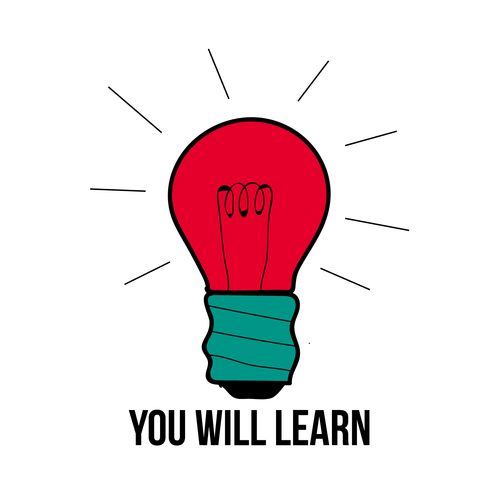
- What stigmas are associated with mental illness and how to identify mental health resources.
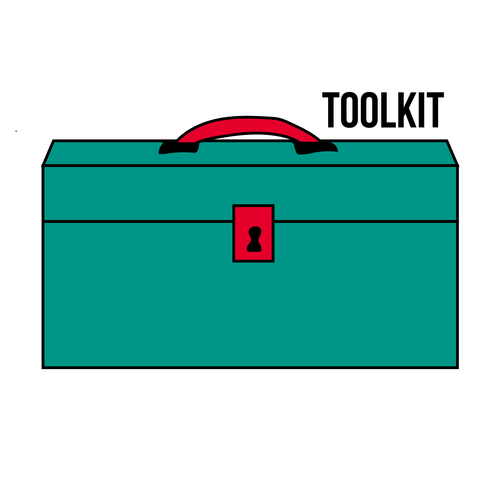
- Worksheets
- Slide presentation
- Paper
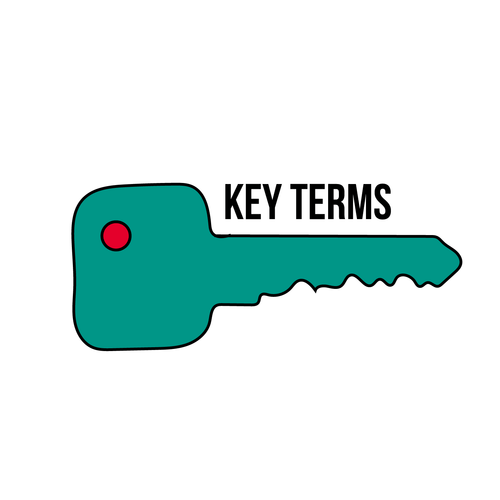
[As defined by MentalHealth.gov, n.d.; American Psychiatric Association, 2015; Merriam-Webster Learner’s Dictionary, n.d.]
- Mental Health: Our emotional, psychological, and social well-being, and it can affect how we think, feel, and act.
- Mental Illness: A health condition involving changes in thinking, emotion or behavior (or a combination of these). Mental illnesses are associated with distress and/or problems functioning in social, work or family activities.
- Stigma: A set of negative and often unfair beliefs that a society or group of people have about something.
- Resource: A place or thing that provides something useful.
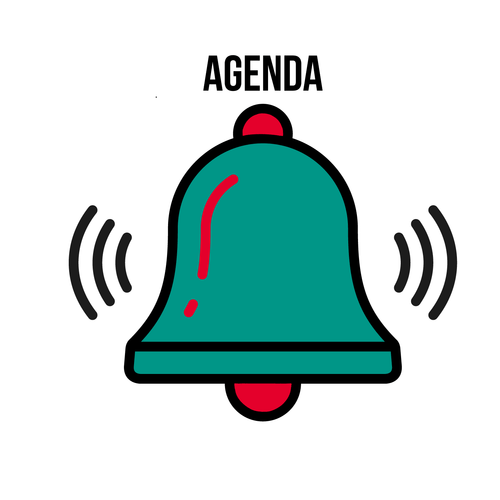
- Do Now
- Mental Health vs. Illness
- Say Goodbye to Stigmas
- Racking Up My Resources
- Exit Ticket
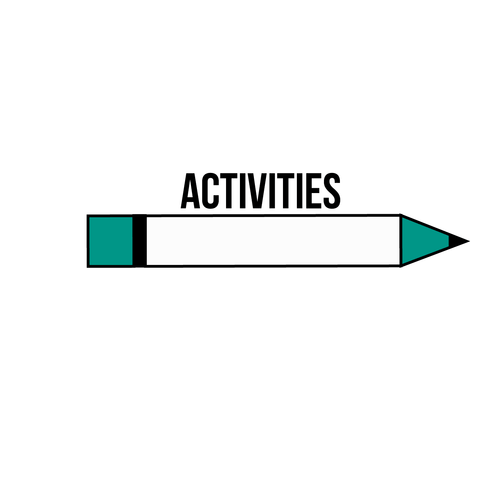
Do Now:
Adapted from Kutcher & Wei, 2015.
- Share:
- Today, we are going to discuss mental health, a topic that many of us know of but may not completely understand.
- The point of today’s lesson is to gauge our understanding of mental health as a group, to dispel some of the stigma surrounding mental illness and to point you in the direction of the mental health resources that we have on campus and in the community if you feel you may need them.
- Trigger Warning: Some of the content we will be discussing today is sensitive and might trigger some negative emotions for you. I have set a chair outside the classroom today. If you feel uncomfortable in any moment today, please feel free to step outside, sit and breathe until you feel comfortable to return to class.
- Set Up:
- Put four pieces of poster paper around the room with the following titles:
- Mental Illness
- Physical Illness
- Physical Health
- Mental Health
- Put four pieces of poster paper around the room with the following titles:
- Instruction:
- Split participants into four groups.
- Each group will be assigned to begin at one poster paper and write down a few words on each paper that come to mind when they see the terms.
- After a certain amount of time (suggest 5-15 minutes), signal (stopping of music playing, gong, whistle, etc.) groups to rotate clockwise or counterclockwise to the next poser paper.
- Repeat until all the groups have visited each poster paper. Have everyone sit down and ask 4 students to read the words on each paper.
- Share:
- What are the similarities and differences you see in the words used on each poster paper?
- How might stigma be related to these differences? Stigma is a set of negative and often unfair beliefs that a society or group of people have about something.
Good to Know: Mental Health vs. Mental Illness
- Share:
- Mental health is our emotional, psychological, and social well-being, and it can affect how we think, feel, and act (MentalHealth.gov, n.d.).
- Mental health is important at every stage of our lives, and it can affect our relationships and our choices.
- Meanwhile, mental illness is a health condition involving changes in thinking, emotion or behavior (or a combination of these). Mental illnesses are associated with distress and/or problems functioning in social, work or family activities (American Psychiatric Association, 2015).
- While everyone has mental health, mental illness affects certain people to varying degrees.
- In fact, it is estimated that about 20% (1 in 5) of teens between the ages of 13-18 experience a mental health issue, 50% (half) of all lifetime cases of mental illness begin by the age of 14 and 75% (3/4) by the age of 24 (American Psychiatric Association, 2015; National Alliance on Mental Health, n.d.).
- Two barriers that discourage people from getting the help they may need are 1) being unaware that they are struggling with mental illness and 2) the fear of stigma and the resulting judgment or discrimination often (Henderson et al., 2013).
- The first barrier exists because often mental illnesses are difficult to recognize. Sometimes they are hard to distinguish from the regular ups and downs of life. For example, it is normal to experience a depressed mood after losing a loved one. However, when that depressed mood continues long after and interrupts normal functioning there may be something deeper going on (American Psychiatric Association, 2015).
- Share:
- What are some general warning signs of mental illness?
- Withdrawal and/or apathy: Recent loss of interest in much of anything including social interactions and an unusually reserved disposition
- The decrease in functioning: An unusual decrease in functioning in school, work, or social activities. For example, an atypical drop in grades, quitting sports or other after-school activities, and a disinterest in social interactions
- The difficulty with brain function: Issues with concentration, memory or logical thought processes and speech.
- Hypersensitivity of senses: Heightened sensitivity of all 5 senses (sight, smell, taste, touch, sound); avoidance of situations that overly engage the senses.
- Feeling disconnected from reality and/or friends/family.
- Nervousness: Consistent nervous feeling/fear or suspiciousness of others.
- Atypical behavior: strange behavior that is uncharacteristic of the individual
- Drastic changes in sleep or appetite
- Consistent drastic shifts in mood
- What are some general warning signs of mental illness?
- Share:
- While it is important to pay attention to the warning signs of mental illness in yourself and your loved ones, these illnesses may look different for each individual and a full diagnosis must come from a mental health professional.
- Towards the end of this lesson, we will be discussing school and community resources where you can find help if you start to recognize these warning signs.
- Share:
- Why do you think it’s important to maintain balanced mental health?
- Responses may include:
- Working productively (school, job, etc.)
- Maintaining a positive sense of self (self-confidence)
- Maintaining healthy relationships (APA, 2015)
- What are some ways to maintain balanced mental health?
- Responses may include:
- Get professional help if you need it
- Say positive affirmations to yourself
- Exercise
- Get enough sleep
- Develop positive coping strategies to handle stress/sadness which may include breathing, meditation, exercise, affirmations, etc.
- Interact with others (gov, n.d.)
- Why do you think it’s important to maintain balanced mental health?
Hands-On: Say Goodbye to Stigmas
- Share:
- As mentioned earlier, one of the barriers that discourage people from getting the help they may need is the fear of stigma and the resulting judgment or discrimination often (Henderson et al., 2013).
- There are many stigmas associated with mental illnesses. Today, let’s debunk some of those stigmas and learn some truths.
- Instruction:
- Have participants face down on their desks.
- Read each question and possible answers out-loud to the group.
- Give participants 1-2 minutes to think over the question before having them vote anonymously on which they think is the correct answer. Then, share the answer with the group.
- Optional: If you use a polling clicker system in your class, you can also use that to conduct this activity.
|
Questions |
Answers |
|
Who experiences mental illnesses? A. People of low socioeconomic status B. People of high socioeconomic status C. Adults D. People of certain races E. All of the above |
E is the correct answer. While certain factors about someone might make them MORE susceptible to mental illness, everyone is at risk—no one type of person is exempt from mental illness. Without realizing it, you probably know someone with a mental health challenge. Many people with mental health challenges are still active members of our community.
|
|
Are mental illnesses real illnesses? A. Yes, they are real illnesses B. No, they are not real illnesses
|
A is the correct answer. Yes. they are real illnesses and should be treated as such. If someone had to have surgery, we wouldn’t tell them to “get over it,” nor would we blame them if they needed to take time to recover—the same goes for mental illnesses, we need to respect them as the real illnesses that they are.
Instruction: Pose the question to the class—what classifies as a real illness? Potential responses: · Something for which you need the help of a doctor · Something that interferes with your daily activities · Something for which you must take medication |
|
What causes mental illnesses? A. The neurological complication in the brain B. Life Experiences C. One’s personality/behaviors D. Stress/Trauma from one’s environment E. A combination of all of the above |
E is the correct answer. Individuals can be more genetically prone to mental illness perhaps because of a family history of some disorder(s). Then life experiences or stress from one’s environment can spark the onset of a mental illness.
|
|
T/F: People can never cope with mental illnesses. A. True B. False
|
B is the correct answer. People with mental illnesses can cope with them. There are many treatments, medications, services, and supports that can help. Even when people battle mental illnesses for a long time, they often learn to manage their symptoms to continue to work towards their goals at work or in school. |
|
T/F: People with mental illnesses are violent and unstable. A. True B. False |
B is the correct answer. In fact, only about 3%-5% of violent acts can be attributed to individuals with a serious mental illness. Most people with mental illnesses are no more likely to be violent than anyone else. |
|
T/F: Most people with mental health challenges get help. A. True B. False
|
B is the correct answer. Unfortunately, only 44% of adults with diagnosable mental illnesses and less than 20% (1 in 5) of children and adolescents receive needed treatment. |
|
T/F: It’s impossible for me to help someone with a mental illness. A. True B. False
|
B is the correct answer. Friends/families can play really important roles! You can help those in need by reaching out and letting them know you are there for them, helping them access resources, treating them with respect, combating stigmas against mental illnesses, or avoiding labels such as “crazy.” However, as loving and caring as you may be, it is important that you do not take on the role of a professional. For the sake of your own mental health and the sake of your loved ones struggling with mental illnesses, you must help connect them to the professional care they may need. |
Source:
- MentalHealth.gov. (n.d.). What is mental health? Retrieved From: www.mentalhealth.gov/basics/what-is-mental-health/index.html
- Optional Instruction:
- Play this video for your group: https://www.youtube.com/watch?v=WrbTbB9tTtA
- Discuss celebrities who have come out and discussed their mental health diagnoses. Some celebrities you could mention include:
- Shawn Mendes (Singer): Anxiety
- Kendall Jenner (Model): Anxiety
- Lady Gaga (Singer): PTSD and Depression
- Demi Lavado (Singer/Actress): Bipolar Disorder
- JK Rowling (Author of Harry Potter): Depression
- Kristen Bell (Actress): Depression
Real World Relevance: Racking Up My Resources
- Set Up:
- Prior to this lesson, research specific campus-wide, community-wide, and nation-wide resources for your group.
- Examples of campus-wide resources: school counselors, school psychologist, therapists with whom the school has a partnership, group therapy on campus, etc.
- Examples of community-wide resources: doctors, therapists/psychologists, suicide prevention, trauma recovery centers, mental health clinics, family therapy services, etc.
- Examples of nationwide resources for immediate help:
- National Suicide Prevention Lifeline(1-800-273-8255). Trained crisis workers are available to talk 24 hours a day, 7 days a week.
- SAMHSA Treatment Referral Helpline(1‑877‑SAMHSA7 or 1‑877‑726‑4727). Get general information on mental health and locate treatment services in your area. Speak to a live person, Monday through Friday from 8 AM to 8 PM EST.
- Examples of nationwide resources for helping a loved one:
- NAMI: https://www.nami.org/Find-Support/Te...-Help-a-Friend
- gov: www.mentalhealth.gov/talk/friends-family-members/index.html
- ULifeline: http://www.ulifeline.org/help_a_friend
- Examples of nationwide resources for information:
- gov: https://www.mentalhealth.gov/
- National Institute of Mental Health: https://www.nimh.nih.gov/
- American Psychological Association: www.apa.org/
- Jed Foundation: https://www.jedfoundation.org/mental-health-resource-center/
- HHS’s Office of Adolescent Health: https://www.hhs.gov/ash/oah/adolescent-development/mental-health/index.html
- AACAP: www.aacap.org/
- NAMI: https://www.nami.org/
- Share:
- Today, you’ve been introduced to the concepts of mental health and mental illness.
- As we’ve discussed, mental illness is not a rare issue, so you may know of someone who suffers from it.
- So, what are some resources in our community for those that may need help with their mental illness?
- Instruction:
- Brainstorm potential campus-wide, community-wide, and nation-wide resources with your group.
- Record and display answer via projector, on a board, on a worksheet, or on flip chart paper.
- After the group finishes brainstorming, this would be a good time for your guest speaker to talk about how to access these resources and answer questions. If there’s time, the guest speaker can also suggest some language that can be used to start a conversation about mental illness with trusted peers/adults.
- If you don’t have a guest speaker, then share with them your list of resources.
- Share:
- If you are struggling with your mental health, you can feel better. If you know someone struggling with their mental health, you can help them feel better.
- One way is by accessing resources, and now we have identified some of those resources in our community!
- However, remember that there are other ways to help friends and family members struggling with mental health, such as treating them with respect, providing emotional support, and combating stigmas against mental illnesses (gov, n.d.).
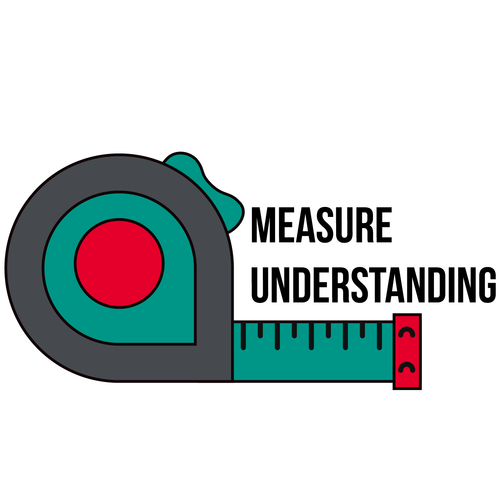
Exit Ticket:
- Instruction:
- Have participants write on their worksheet or share out loud the following question(s).
- What was the most surprising/interesting fact you learned today? Why?
- What are some strategies to maintain positive mental health that you will try?
- If you were suffering from mental health issues, who would you feel comfortable reaching out to?
- Have participants write on their worksheet or share out loud the following question(s).
Bibliography
- American Psychiatric Association. (2015). What is mental illness? Retrieved From: https://www.psychiatry.org/patients-families/what-is-mental-illness
- American Psychiatric Association. (2017). What are anxiety disorders? Retrieved From: https://www.psychiatry.org/patients-families/anxiety-disorders/what-are-anxiety-disorders
- American Psychiatric Association. (2017). What is depression? Retrieved From: https://www.psychiatry.org/patients-...-is-depression
- Henderson, C., Evans-Lacko, S., & Thornicoft, G. (2013). Mental Illness Stigma, Help Seeking, and Public Health Programs. Am J Public Health 103(5): 777–780.
- Internal Revenue Service (n.d.) New Requirements for 501(c)(3) Hospitals Under the Affordable Care Act. https://www.irs.gov/charities-non-profits/charitable-organizations/new-requirements-for-501c3-hospitals-under-the-affordable-care-act gov. (n.d.). What is mental health? Retrieved From: www.mentalhealth.gov/basics/...lth/index.html
- Merriam-Webster Learner’s Dictionary. (n.d.). Resource. Retrieved From: http://www.learnersdictionary.com/definition/resource
- Merriam-Webster Learner’s Dictionary. (n.d.). Stigma. Retrieved From: http://www.learnersdictionary.com/definition/stigma
- Kutcher, S. & Wei, Y. (2015). Mental health & high school: Curriculum guide. Retrieved From: teenmentalhealth.org/curriculum/wp-content/uploads/2015/06/DRAFT-6-2015-Version-New-Design.compressed.pdf
- TedX Talks. (2016). Image there Was No Stigma to Mental Illness | Dr. Jeffrey Lieberman. Retrieved From: https://www.youtube.com/watch?v=WrbTbB9tTtA

- TedX Talks. (2015). Rewriting the Stigma of Mental Illness | Paige Freeman. Retrieved From: https://www.youtube.com/watch?v=p5-YwRad-rs
- Optional Good to Know Activity:
- Instruction: Display the following infographic(s) on a board. Discuss the statistics with the group. What is surprising? Does knowing these statistics change their thoughts on mental illness/health? How and why?
- Infographics on Mental Health Facts (NAMI, n.d.):
- Education-Training and Outreach Programs. https://www.nami.org/Extranet/Education-Training-and-Outreach-Programs/Outreach-and-Advocacy/NAMI-Smarts/Teacher-Materials (NAMI, n.d.)
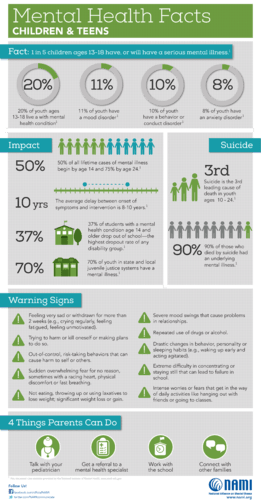 Children Facts by National Alliance of Mental Illness
Children Facts by National Alliance of Mental Illness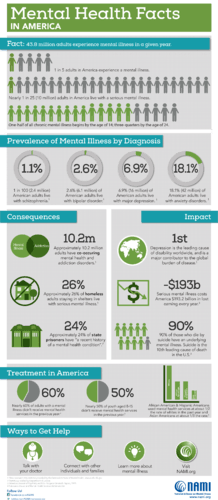 Adult Facts by National Alliance of Mental Illness
Adult Facts by National Alliance of Mental IllnessThis lesson was created in partnership with Albert Einstein College of Medicine Department of Epidemiology and Population Health with funding support by the National Institutes of Health NIDDK Grant R01DK097096.

